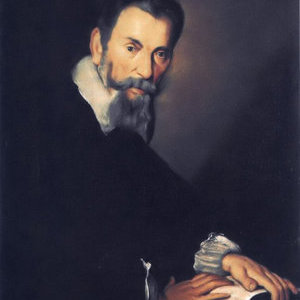Claudio Monteverdi (1567-1643)
Musica Profana

Le grazie d’amore
madrigali e sonate nell’età di Claudio Monteverdi
- CLAUDIO MONTEVERDI (1567-1643) – “De la bellezza le dovute lodi” a 3 voci
- CLAUDIO MONTEVERDI – “Clori amorosa” 1 a 3 voci
- DARIO CASTELLO (sec. XVII) – Sonata Terza a due canti e basso continuo
- CLAUDIO MONTEVERDI – “Ahi com’a un vago sol” a 5 voci concertato
- CLAUDIO MONTEVERDI – “Troppo ben può” 3 a 5 voci concertato
- CLAUDIO MONTEVERDI – “Et è pur dunque vero” a voce sola con violino
- TARQUINIO MERULA (1595-1665) – Chiacona a due canti e basso continuo
- CLAUDIO MONTEVERDI – “Zefiro torna” 4 a due tenori concertati
- CLAUDIO MONTEVERDI – “Non è di gentil core” a due soprani concertati
- CLAUDIO MONTEVERDI – “T’amo mia vita” 3 a 5 voci concertato
- DARIO CASTELLO – Sonata Quarta2 a due canti e basso continuo
- GIULIO CESARE MONTEVERDI (1573-1630) – “Deh chi tace il bel pensero” 1 a 3 voci
This is a program of music where the subject of the texts is love: let us imagine a feast in an ancient noble manor with an audience of amateurs. Here you find some of the beloved poets of the early XVII century: Gabriello Chiabrera, Giovan Battista Guarini, Ottavio Rinuccini, Francesca Degli Atti Gonzaga, Ansaldo Cebà andFerdinando Gonzaga himself. Love and beauty are praised both in the lighter music of the Scherzi Musicali, and in the deeperrand more moving madrigals of the V book by Monteverdi, where, for the first time we meet the harpsichord. The three solo madrigals render even more emotional the recital, especially “Ed è pur dunque vero” where you find betrayal, deception and betrayed faithl. The intense expression of these texts is alternated with illustrious sonatas (Castello was the leader of the instruments at St. Mark’s in Venice). The ciaccona by Merula is an introduction to the vocal one of “Zefiro torna” by Monteverdi. The title of the program is taken from a treatise by Cesare Negri, published in Milan in 1602: the program is a sequence of some of the most refined pieces, both vocal and instrumental that give a significant idea of the venetian musical culture in the early XVII century.
